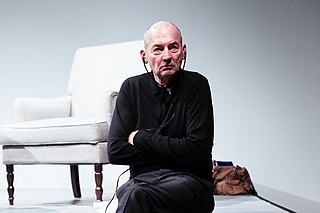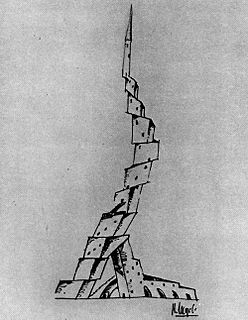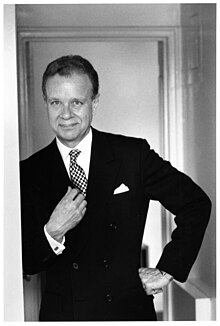
Remment Lucas Koolhaas is a Dutch architect, architectural theorist, urbanist and Professor in Practice of Architecture and Urban Design at the Graduate School of Design at Harvard University. He is often cited as a representative of Deconstructivism and is the author of Delirious New York: A Retroactive Manifesto for Manhattan.

Dame Zaha Mohammad Hadid was a British-Iraqi architect, artist and designer, recognised as a major figure in architecture of the late 20th and early 21st centuries. Born in Baghdad, Iraq, Hadid studied mathematics as an undergraduate and then enrolled at the Architectural Association School of Architecture in 1972. In search of an alternative system to traditional architectural drawing, and influenced by Suprematism and the Russian avant-garde, Hadid adopted painting as a design tool and abstraction as an investigative principle to "reinvestigate the aborted and untested experiments of Modernism [...] to unveil new fields of building."
The year 2004 in architecture involved some significant architectural events and new buildings.

Herbert Mitchell Muschamp was an American architecture critic.
Starchitect is a portmanteau used to describe architects whose celebrity and critical acclaim have transformed them into idols of the architecture world and may even have given them some degree of fame among the general public. Celebrity status is generally associated with avant-gardist novelty. Developers around the world have proven eager to sign up "top talent" (i.e., starchitects) in hopes of convincing reluctant municipalities to approve large developments, of obtaining financing or of increasing the value of their buildings. A key characteristic is that the starchitecture is almost always "iconic" and highly visible within the site or context. As the status is dependent on current visibility in the media, fading media status implies that architects lose "starchitect" status—hence a list can be drawn up of former "starchitects".

Contemporary architecture is the architecture of the 21st century. No single style is dominant. Contemporary architects work in several different styles, from postmodernism, high-tech architecture and new interpretations of traditional architecture to highly conceptual forms and designs, resembling sculpture on an enormous scale. Some of these styles and approaches make use of very advanced technology and modern building materials, such as tube structures which allow construction of buildings that are taller, lighter and stronger than those in the 20th century, while others prioritize the use of natural and ecological materials like stone, wood and lime. One technology that is common to all forms of contemporary architecture is the use of new techniques of computer-aided design, which allow buildings to be designed and modeled on computers in three dimensions, and constructed with more precision and speed.

Mark Antony Wigley is a New Zealand-born architect and author based in the United States. From 2004 to 2014, he was the Dean of Columbia University's Graduate School of Architecture, Planning and Preservation.

Deconstructivism is a movement of postmodern architecture which appeared in the 1980s. It gives the impression of the fragmentation of the constructed building, commonly characterised by an absence of obvious harmony, continuity, or symmetry. Its name is a portmanteau of Constructivism and "Deconstruction", a form of semiotic analysis developed by the French philosopher Jacques Derrida. Architects whose work is often described as deconstructivist include Zaha Hadid, Peter Eisenman, Frank Gehry, Rem Koolhaas, Daniel Libeskind, Bernard Tschumi, and Coop Himmelb(l)au.
Madelon Vriesendorp is a Dutch artist, painter, sculptor and art collector. She was married to Rem Koolhaas and best known as one of the co-founders of the Office of Metropolitan Architecture (OMA) in the early 1970s. Vriesendorp would often create visuals and graphics for OMA in the early years.

The Contemporary Arts Center (CAC) is a contemporary art museum in Cincinnati, Ohio and one of the first contemporary art institutions in the United States. The CAC is a non-collecting museum that focuses on new developments in painting, sculpture, photography, architecture, performance art and new media. Focusing on programming that reflects "the art of the last five minutes", the CAC has displayed the works of many now-famous artists early in their careers, including Andy Warhol. In 2003, the CAC moved to a new building designed by the late Zaha Hadid.
Aaron Betsky, born 1958 in Missoula, Montana, is an American critic on art, architecture and design. He was the director of Virginia Tech's School of Architecture + Design until early 2022. Trained as an architect and in the humanities at Yale University, he is the author of over a dozen books, including Architecture Matters, Making It Modern, Landscrapers: Building With the Land, Scanning: The Aberrant Architectures of Diller + Scofidio, Queer Space, Revelatory Landscapes, and Architecture Must Burn. Internationally known as a lecturer, curator, reviewer and commentator, he writes the blog "Beyond Buildings" for Architect Magazine. Director of the 11th Venice Architecture Biennale, he has also been president and Dean of the School of Architecture at Taliesin, director of the Netherlands Architecture Institute (2001-2006) the Cincinnati Art Museum (2006-2014), and was founding Curator of Architecture, Design and Digital Projects at the San Francisco Museum of Modern Art (1995-2001). As an unlicensed architect, he worked for Frank O. Gehry & Associates and Hodgetts + Fung. In 2003, he co-curated "Scanning: The Aberrant Architectures of Diller + Scofidio" at the Whitney Museum of American Art.

Vilnius Guggenheim Hermitage Museum was a proposed art museum in the city of Vilnius, the capital of Lithuania. On April 8, 2008 an international jury named Zaha Hadid, a British-Iraqi architect, the winner of the international design competition for the museum. The museum was initially scheduled to open in 2011. Later, it was announced, that museum was scheduled to open in 2013. However, the project was postponed due to alleged illegal channeling of funds to the Jonas Mekas Arts Center and has been under investigation since 2010. The museum project, as of March 2012, was reported as having regained support, including that of the Vilnius mayor, Arturas Zuokas, even though the embezzlement inquiry was still ongoing.

Hélène Binet is a Swiss-French architectural photographer based in London, who is also one of the leading architectural photographers in the world. She is most known for her work with architects Daniel Libeskind, Peter Zumthor and Zaha Hadid, and has published books on works of several architects.
Pin–Up is a biannual independent architecture and design magazine based in New York City. The subtitle of the magazine is The Magazine for Architectural Entertainment. Pin-Up was founded in 2006 by architect, curator, and creative director Felix Burrichter. Burrichter currently serves as creative director of the publication.
The year 2010 in architecture involved some significant architectural events and new buildings.

Guangzhou Opera House is a Chinese opera house in Guangzhou, Guangdong province, People's Republic of China. Designed by Zaha Hadid, it opened on 9 May in 2010.
The year 2011 in architecture involved some significant architectural events and new buildings.
The year 2016 in architecture involved some significant architectural events and new buildings.

Avant-garde architecture is architecture which is innovative and radical. There have been a variety of architects and movements whose work has been characterised in this way, especially Modernism. Other examples include Constructivism, Neoplasticism, Neo-futurism, Deconstructivism, Parametricism and Expressionism.
Christophe Van Gerrewey is a Belgian architectural and literary theorist, writer and architect. He is currently tenure track professor for architectures, criticism, history and theory at the School of Architecture, Civil and Environmental Engineering (ENAC) of the École Polytechnique Fédérale de Lausanne (EPFL).











